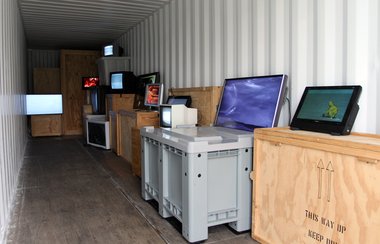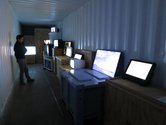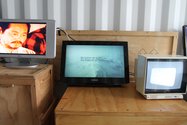John Hurrell – 9 October, 2012
If it were displayed in a science fair, far away from an art contextualising framework then viewers' interpretations would be very different. It would be subversive. Here though the large wall label on the container exterior states the artist's aims and pre-empts a spontaneous viewer response; an explanatory intention is elucidated. It is clearly art, perpetuating an ‘art' ethos.
Christchurch
Ruth Watson
From White Darkness
14 September - 14 October 2012
In Christchurch, as part of NZ Ice Fest in North Hagley Park, this exhibition by Ruth Watson is her second Antarctica focussed show in a few months. Presented inside a narrow metal shipping container, it was curated by Felicity Milburn as part of the Christchurch Art Gallery’s post-earthquake Outer Spaces programme.
Sited between the Armagh St gates and Victoria Lake, the large transportable oblong box you walk into has various wooden crates and multi-sized plastic containers pressed up against one long wall. On these are positioned thirteen video monitors of various types, sizes and ages, showing assorted loops of archival film and home videos made during Watson’s stay there. As the old and more recent loops are of different lengths, they vary in synchronicity, according to where - within the cramped space - you happen to be standing. You tend to make connections between screens that are close to each other when formal or conceptual parallels occur.
Most of the imagery is of scientists working on the southern ice, sending up meteorological balloons, drawing and examining maps, conversing, or recording data. Because of the colour of some of the archival material and the striking nature of some of the more dramatic imagery, there is an aesthetic that makes you linger. Though the work is intended to deconstruct the programmatic assumptions of science - accentuating its speculative aspects - that doesn’t really happen, because of the art context which espouses such values.
If it were displayed in a science fair, far away from an art contextualising framework then viewers’ interpretations would be very different. It would be subversive. Here though the large wall label on the container exterior states the artist’s aims and pre-empts a spontaneous viewer response; an explanatory intention is elucidated. It is clearly art, perpetuating an ‘art’ ethos.
Of the nearby (non-art) exhibits, probably the display with the most affective punch is the presentation in a crate of Christchurch’s marble statue of Captain Scott, lying on its side and badly damaged by the earthquake. Normally admired amongst the Avon’s flower beds next to the Worcester St Bridge, its now pitiful horizontal state reflects the historical status of Scott’s expedition (aspirations of Empire) and his current reputation as leader - compared to say Shackleton or Amundsen.
It might be surmised that this prone broken carving coincidentally symbolises the indeterminate role of science, its unstable epistemological state, a lack of certainty in any foundation or useful predictability, but I doubt whether many scientists on the ice would see their discipline that way. In their eyes (unlike Watson’s) the two paradigms of art and science remain separate and are not close to being interchangeable.
John Hurrell
Recent Comments
John Hurrell
If we consider the popular (post-grad) vogue for young artists to collaborate with experts in other disciplines (usually science, sometimes ...
simon glaister
...hmmm, it would appear i should spend more time investigating the many links you judiciously provide! I did see Ruth's ...
John Hurrell
Thanks for your considerable thought on this, Simon. I did provide a link in the third paragraph to a press ...




 Advertising in this column
Advertising in this column Two Rooms presents a program of residencies and projects
Two Rooms presents a program of residencies and projects



This Discussion has 4 comments.
Comment
simon glaister, 1:03 a.m. 10 October, 2012 #
"Though the work is intended to deconstruct the programmatic assumptions of science - accentuating its speculative aspects - that doesn’t really happen, because of the art context which espouses such values."
Hi John, what makes you certain about the intentions of this installation? Perhaps you are projecting onto the work the very values you claim its context espouses? This sounds like a reading based at least in part on a-priory ideas regarding what art is and is not... which is funny given the review's title - to paraphrase David Hume "comparison [being] first and foremost an a-posteriori Art".
I have not seen the work, so i have no view on it. However, i can report that in comparing my own experiences in the applied sciences and fine arts the vector of deconstruction is typically reversed - the experimental sciences being 'The Art' (Hume again) of individuation of material phenomena, and Art being the reflexive expression of subjective experience grounded in the emergent conditions of 'collective reality'. I have rarely encountered Art that surpasses in intensity the sculptural, formal, or speculative qualities of a well composed scientific experiment, and when i have, it is typically due the works to mimicry of/dependance on experimental method masquerading as 'critique'. Speculating a little myself, perhaps an essential difference between the two lies in their approach to composition of the contrast space?
While science may have many undisclosed programmatic assumptions 'speculation' is not one of them... Is it possible Watson is simply appealing to the material properties, formal qualities and raw intensities of the scientific processes she is documenting? and that the failed deconstruction, obscured by "the context which itself espouses such values" is in instead the result your a-priory resistance to see what is actually there? to read the work in light of the values espoused by the object it documents, the comparative a-posteriori values of the experimental sciences?
John Hurrell, 8:19 a.m. 10 October, 2012 #
Thanks for your considerable thought on this, Simon. I did provide a link in the third paragraph to a press release promoting the show. It gives a sense of the flavour of the label with very interesting comments by Felicity Milburn and Jenny Harper.
simon glaister, 11:19 p.m. 10 October, 2012 #
...hmmm, it would appear i should spend more time investigating the many links you judiciously provide!
I did see Ruth's previous show at Two Rooms Gallery here in Auckland. The programmatic assumptions of cartography, and the inevitable abstraction that is always its virtue are, on the surface at least, much more open to the "accentuation of [their] speculative aspects" than the physical processes of raw data collection and applied science.
Perhaps the (typical) misapplication these intentions to 'science in general' is at the heart of your reaction to this second installment?
John Hurrell, 12:57 a.m. 11 October, 2012 #
If we consider the popular (post-grad) vogue for young artists to collaborate with experts in other disciplines (usually science, sometimes history) it is invariably the artists who initiate such liaisons. Because such attitudes are part of the 'art' paradigm, the speculative mindset and intellectual enthusiasm is on their side, not the other way around. I suspect most scientists would be astounded if their colleagues supported a 'loosey goosey' experimental possibility, and baffled that an artist could view science that way.
Participate
Register to Participate.
Sign in
Sign in to an existing account.